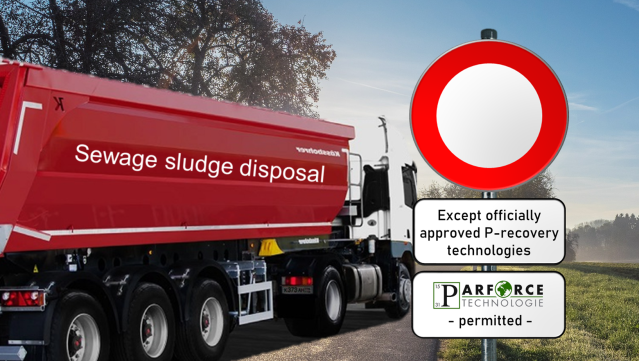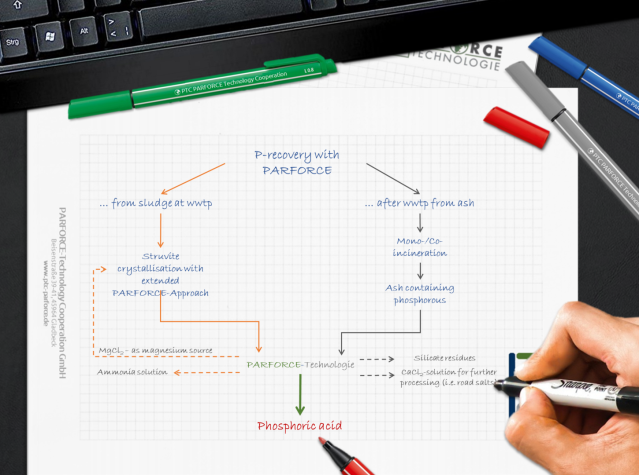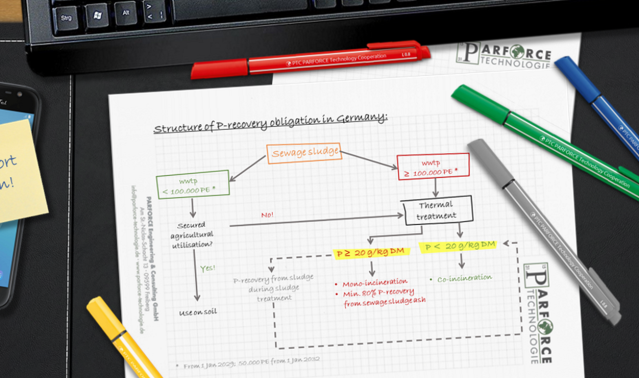What solutions do we offer to meet your challenges stemming from the amended German Sewage Sludge Ordinance (AbfKlärV 2017)?
Challenges of the AbfKlärV 2017
The obligation to thermally recycle sewage sludge and the phosphorus recovery obligation from 1 January 2029 onwards under the Sewage Sludge Ordinance (AbfKlärV 2017) poses a number of technical, business management and legal challenges for municipal and industrial sewage sludge producers.
We support your
- analysis of the necessary adjustments in operations at the sewage treatment plant due to the changing legal framework for sewage sludge disposal,
- identification of viable options to meet the requirements of the AbfKlärV
- and preparation of the concept, that has to be submitted to the authorities by the end of 2023.
… subsequent implementation of the developed concept.
... regardless of whether you are aiming for phosphorus depletion at the wastewater treatment plant under water management act or recovery from sewage sludge ash under waste management act.
Strategic options with PARFORCE technology
With our flexible PARFORCE-Technology and our comprehensive consulting approach based on sound analyses, we can offer you tailor-made solutions.
Phosphorus separation at the wastewater treatment plant according to water management act:
If you remove or are able to remove phosphorus from waste water mainly through biological processes (Bio-P), there is the option of feeding your sewage sludge to co-incineration (e.g. cement plant) through intensified struvite separation.
With the patent-pending "extended PARFORCE approach", known process principles of sludge treatment are adapted and combined so that up to 2/3 of the phosphorus contained in the sludge can be separated.
The separated struvite (also called MAP - magnesium ammonium phosphate) can then be refined to high-quality phosphoric acid using the PARFORCE technology. The refinement of struvite to phosphoric acid is relatively uncomplicated with the PARFORCE Technology due to the relatively high purity and clearly defined crystal structure of struvite.
As a by-product of the struvite refinement to phosphoric acid, magnesium chloride (MgCl2) is produced, which can be returned to the sludge treatment as a magnesium source for renewed struvite crystallisation. No residues remain.
The separation of ortho-phosphate also significantly reduces frequent operating problems caused by spontaneous incrustations and by backloading of the biology.
The separation of phosphate at the sewage treatment plant, the refinement of the struvite to phosphoric acid and the thermal utilisation
in co-incineration is much more environmentally friendly and cost-effective than the mono-incineration of sewage sludge with subsequent P recovery from ash.
Contact us!
We support you in the analysis, evaluation and implementation of this option.
Phosphorus recovery from sewage sludge ash according to waste management act:
In Germany, phosphorus is mainly removed chemically from the wastewater stream. Iron and aluminium phosphate is precipitated in the sewage sludge, using iron- or aluminium-based precipitating salts.
Iron and aluminium phosphates are very stable compounds and a release of phosphorus (transfer of phosphorus into the dissolved state) is only possible under strong pH value reductions (~pH value < 3.5). For this reason, separating phosphate at a wastewater treatment plant, which precipitates P chemically, is technically extremely complex, ecologically questionable and economically unjustifiable. In the case of chemical phosphate precipitation, recovery from ash after prior thermal treatment of the sewage sludge - usually in mono-sludge incineration plants – is the single remaining viable option to recover Phosphorus.
The PARFORCE-Technology designed to recover P from sewage sludge ash, does not produce additional residues such as gypsum or similar due to the special process technology used.
Structure of the German Sewage Sludge Ordinance
From 1 January 2029 onwards, the obligation to recover phosphorus comes into force if the sewage sludge dry matter contains 2% (threshold value) or more of phosphorus.
The agricultural utilisation of sewage sludge is then no longer permissible. Co-incineration is also only possible if phosphorus has already been sufficiently separated at the sewage treatment plant.
In legal terms, sewage sludge is waste from the completed wastewater treatment. The Sewage Sludge Ordinance is a special provision in German waste law and, until its amendment in October 2017, exclusively regulated the conditions that made soil-related utilisation (agricultural for fertilisation purposes or for agricultural backfilling) of sewage sludge possible.
The revised AbfKlärV (BGBl. I, p. 3465) has been formulated as a so called article law.
The articles enter into force on specific dates and successively amend the ordinance.
Article 4 of the law regulates the preparation of the implementation of phosphorus recovery and enters into force on 1 January 2023. The actual obligation to thermally recycle sewage sludge and the rules for phosphorus recovery are determined in Article 5. Article 5 shall enter into force on 1 January 2029. Article 6 enters into force on 1 January 2032 and extends the scope of application to sewage treatment plants with a capacity of 50,000 PE. From 2029 onwards, soil-related recovery will only be possible in rare or time-limited exceptional cases.
According to Article 4, all sewage treatment plant operators must, on the one hand, determine the phosphorus content of their sewage sludge in 2023 and, on the other hand, submit a concept to the competent authorities by 31 December 2023 on how phosphorus recovery is to be implemented. The concept shall describe, what actions have been taken until then and which further measures are planned until 2029 in order to fulfil the legal requirement to recover P. In 2027, the phosphorus measurement shall be repeated and an updated concept shall be submitted to the authorities.
[RL] 19.05.2021, 11:20 Uhr





